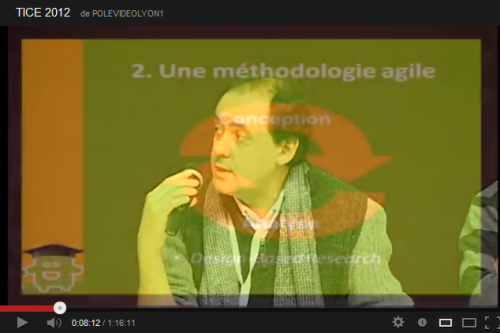07/10/2013
Communication à ECGBL 2013
 Monod-Ansaldi, R, Sanchez, E, Devallois, D, Abad, T, Bénech, P, Brondex, A, , Mazzella, I, Miranda, S, Richet, C, Recurt, C. (2013). Sit down to Table and Confess who you are! Design of an epistemic game for nutritional education at secondary school. Paper presented at the 7th European Conference on Games Based Learning - ECGBL 2013, Porto, Portugal.
Monod-Ansaldi, R, Sanchez, E, Devallois, D, Abad, T, Bénech, P, Brondex, A, , Mazzella, I, Miranda, S, Richet, C, Recurt, C. (2013). Sit down to Table and Confess who you are! Design of an epistemic game for nutritional education at secondary school. Paper presented at the 7th European Conference on Games Based Learning - ECGBL 2013, Porto, Portugal.
Abstract: Nutrition is a complex behaviour. The choices made depend on multiple dimensions as taste, physiological consequences, cultural aspects, or environmen-tal and economic impacts. Rather than transmitting standards to follow, nutrition education might help people to take into account the complexity of the problem, to reflect on all the dimensions involved in nutrition and to make informed choic-es. The French-Canadian research project Jouer pour apprendre en ligne aims at designing and studying digital epistemic games (Shaffer, 2007) that address such complex problems. Epistemic games are playful, complex, realistic, authentic and non-deterministic learning situations that deal with ill-structured problems (King & Kitchener, 1994). Rather than having a unique solution they have solutions that depend on the available information, knowledge and values. Within this context, we used the 3E model (Sanchez & al., 2012)- a tridimensional model for game design - to design “Mets-toi à table !” (“Sit down to table and confess who you are!”), a digital epistemic game about nutritional education. Our research meth-odology consists in a Design-Based Research approach which allows identifying the key factors that have to be taken into account to enroll, entertain and edu-cate the player/learner. Therefore, our work is based on a collaborative research which enables teachers and researchers to iteratively combine design and analysis within an ecological context. The results of this research are both pragmatic (the design of the game) and heuristic (understanding the impact of the game design on the learning process). The data collected encompasses the recording of the students during the game session and focus groups carried out with teachers and students. The analysis of the impact of the choices made for the game design permits to reconsider the design of the game. Indeed, the findings of the first it-eration, which bring little play and little learning to the students, lead to modify the gameplay. In this paper we present the game, the methodology of the re-search and we discuss the key factors that should be taken into account to design a digital epistemic game.
23:05 Publié dans Jeux et apprentissage/games and learning | Lien permanent | Commentaires (0)
22/12/2012
Table ronde Serious Games à TICE 2012
00:34 Publié dans Jeux et apprentissage/games and learning | Lien permanent | Commentaires (0)
20/08/2012
Serious game ou serious play ? Interactions et apprentissage avec des jeux sérieux
 . Sanchez E. (2012). Serious game ou serious play ? Interactions et apprentissage avec des jeux sérieux. ARGOS, CNDP.
. Sanchez E. (2012). Serious game ou serious play ? Interactions et apprentissage avec des jeux sérieux. ARGOS, CNDP.
L’oxymore jeu sérieux semble avoir été introduit pour la première fois par La Bruyère, dans les Caractères (1668), pour décrire le climat qui régnait à la cour du roi de France. D’emblée, l’expression a donc été employée pour désigner une situation mêlant la frivolité des comportements et l’importance des enjeux. Aujourd’hui, le terme s’est popularisé et c’est le plus souvent l’expression anglaise serious game qui est utilisée pour désigner des jeux vidéo employés à des fins utilitaires, en particulier d’éducation ou de formation.
Dans cet article, nous discutons cette définition et nous abordons la question des apprentissages et de leur évaluation avec de tels dispositifs. Au-delà de leur impact sur la motivation relevé par la majorité de leurs partisans quels sont leurs apports pour l’apprentissage ? Comment ces apprentissages peuvent-ils être évalués ? ...
14:23 Publié dans Jeux et apprentissage/games and learning | Lien permanent | Commentaires (0)




